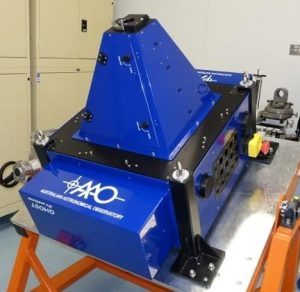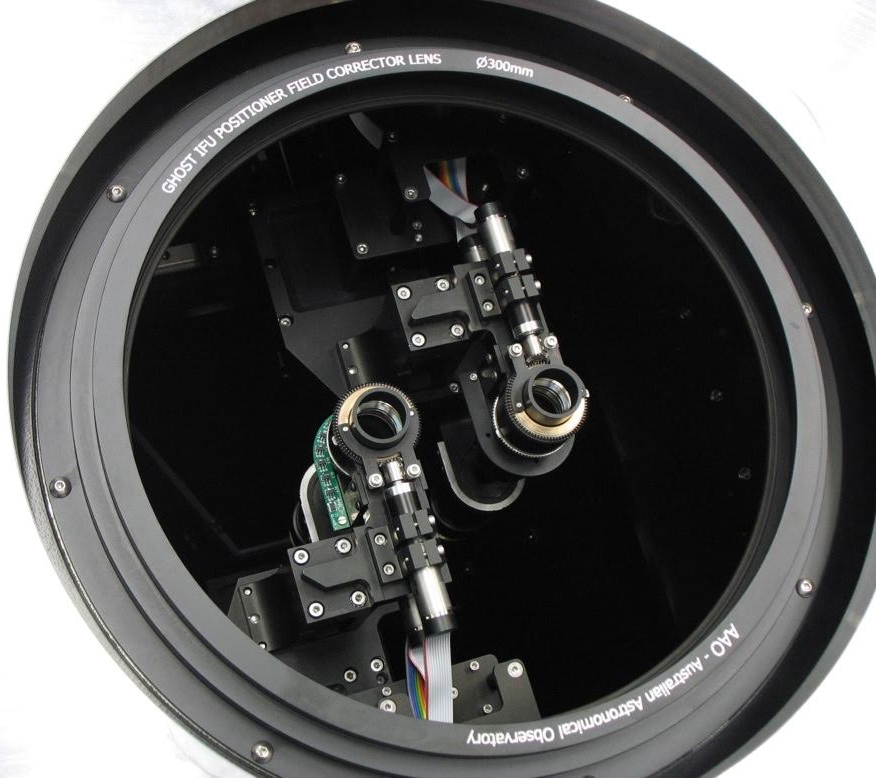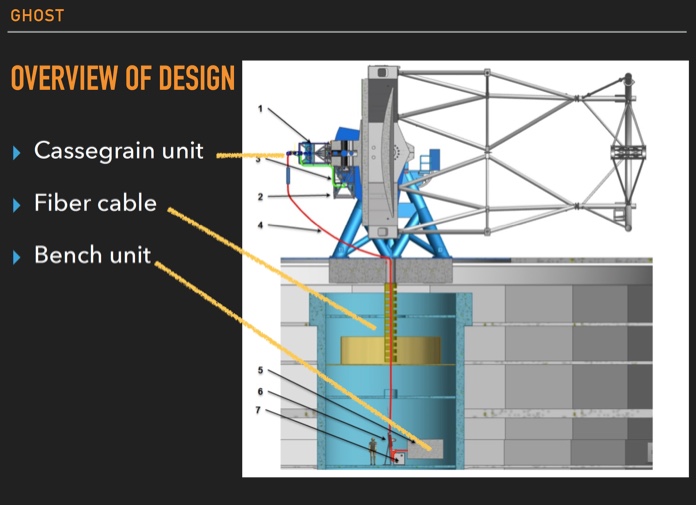Latest News September 2017
GHOST is currently in the build phase. The hardware for the GHOST Cassegrain unit has been successfully assembled in the lab at the AAO in Sydney. During September the electronics should be completed and the ANU will be working on the software to prepare this assembly for test.
Requirements verification testing will proceed over the next few months with the goal to ship this assembly and the prototype optical cable to Gemini South before the end of 2017. Upon arrival, we will perform limited testing on the telescope to ensure all is working and ready for the arrival of the spectrograph expected in 2018.


What is GHOST?
GHOST, the Gemini High-resolution Optical SpecTrograph is the next Gemini facility instrument and will provide world-class, high-resolution spectroscopic capabilities to the Gemini community. GHOST will provide a wide simultaneous wavelength coverage at high observational efficiency, enabling astronomers to investigate a broad range of science from the composition of the first stars to the characterization of exoplanetary systems. A data reduction pipeline will be delivered with the instrument.
The Australian Astronomical Observatory leads the GHOST team which includes the National Research Council Herzberg (NRC-H) for the construction of the spectrograph and the Australian National University (ANU) for instrument control system and data reduction software.
GHOST Science Cases
Designed to be a workhorse instrument, GHOST’s world-class efficiency, resolution, wavelength coverage, and stability will enable a broad range of science by the Gemini community. Scientific expertise and guidance for the development of GHOST is provided by the Combined Science Team, joint led by Michael Ireland (ANU) and Verne Smith (NOAO).
Examples include:
- Characterization of exoplanet systems
- Extremely metal-poor stars in the Milky Way and nearby dwarf satellites
- Follow-up of GAIA targets.
- Radial velocity confirmation of transiting planet candidates particularly from TESS
- Abundance studies of extra-galactic globular clusters
GHOST Instrument Design
GHOST provides simultaneous wavelength coverage from 363 nm to 950 nm. It has two selectable spectral resolution modes: standard-resolution mode with R>50,000 and high-resolution mode with R>75,000. The instrument will obtain a limiting magnitude of 17.5 at 450 nm (30 sigma per resolution element). GHOST will spatially sample each target object over a field size of 1.2 arcsec, well matched to the wide range of seeing conditions at the observatory.
In standard-resolution mode, GHOST will have the capability to observe 2 targets simultaneously over a 7.5 arcmin diameter field of view and provide a radial velocity precision of 600 m/s over the entire wavelength bandpass. GHOST will have the capability to provide a radial velocity precision of ~10 m/s over the wavelength range from 430nm to 750nm in the high-resolution mode, which will utilize a simultaneous ThXe calibration source.
GHOST consists of three primary components; the Cassegrain unit mounted on the telescope, the spectrograph bench located in the pier lab, and a fiber cable connecting the two. The Cassegrain unit contains the positioning arm system, the object and sky fiber IFUs, and mini-ADCs. The bench spectrograph is isolated in the telescope pier lab for image and wavelength stability.
The GHOST spectrograph is an echelle white-pupil design, using VPH grating for cross-dispersion. A slit unit camera provides for object acquisition and active monitoring of the slit illumination. The bench uses active thermal stabilization to help provide the image and wavelength stability necessary for operation efficiency and radial velocity precision.




Link to SPIE 2014 & 2016 conference papers.
The GHOST Team
Gemini
- David Henderson, Project Manager
- Cathy Blough, Project Support
- Natalia Gonzalez, Project Support
- Manuel Lazo, Project Engineer
- John Basset, Systems Engineer
- Steve Margheim, Project Scientist
- Gabriel Perez, Mechanical Engineer
- Cristian Urrutia, Software Engineer
- Luc Boucher, Detector Engineer
- Kathleen Labrie, Data Reduction Software Engineer
- Manuel Gomez, Science Operations Specialist
AAO
- Gabriella Baker, Project Manager
- Richard McDermid, Project Scientist
- Gordon Robertson, Instrument Scientist
- Vladimir Churilov, Mechanical Engineer
- Tony Farrell, Software Engineer
- Ross Zhelem, Optical Engineer
- Yuriy Kondrat, Mechanical Engineer
- Lew Waller, Electronics Engineer
- Michael Edgar, Project Engineer
NRC Hertzberg
- John Pazder, Project and Optical Engineer
- Andre Anthony, Mechanical Engineer
- Greg Burley, Project Manager and Detector Engineer
- Jennifer Dunn, Software Engineer
- Scott MacDonald, Electronics
- Mark Halman, Electronics
- Joeleff Fitzsimmons, Mechanical
ANU
- Michael Ireland, Project Scientist
- Peter Young, Project Manager
- Jon Nielson, Software Engineering Technical Lead
- Lance Luvaul, Software Engineer
- Marc White, Data Reduction Programmer
- Rob Sharp, Instrument Scientist
